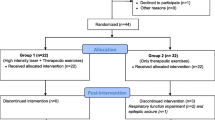Abstract
Objective
To explore the clinical efficacy of sinew-regulating and bone-setting manipulation combined with functional exercise to treat mild to moderate rotator cuff injury (RCI).
Methods
Forty patients with mild to moderate RCI were randomly divided into a treatment group and a control group, with 20 cases in each group. The treatment group was given sinew-regulating and bone-setting manipulation combined with functional exercise, and the control group was given the same manipulation as the treatment group. The therapeutic effect on the functional improvement was assessed after treatment according to pain threshold, shoulder range of motion (ROM) including flexion, abduction, internal rotation and external rotation, and the University of California at Los Angeles (UCLA) shoulder rating score.
Results
Compared with the same group before treatment, the pain threshold, shoulder flexion, abduction, internal and external rotations increased after the treatment in the two groups (all P<0.05). The UCLA shoulder rating score increased (both P<0.05). The improvement in the treatment group is significantly better than that in the control group with a statistical significance (P<0.05). The total effective rate was 95.0% in the treatment group, was higher than 65.0% in the control group (P<0.05).
Conclusion
The sinew-regulating and bone-setting manipulation combined with functional exercise relieve the pain of patients with mild to moderate RCI, increase the motion of shoulder joints, and improve the quality of life of patients. The curative effect is better than the treatment of simple sinew-regulating and bone-setting manipulation.
摘要
目的
探讨理筋正骨手法联合功能锻炼治疗轻中度肩袖损伤的临床疗效。
方法
选择40例轻中度肩袖损伤的患者, 随机分为治疗组和对照组, 每组20例。治疗组给予理筋正骨疗法和功能锻炼, 对照组给予与治疗组相同的理筋正骨手法治疗。依据治疗前后患者压痛程度, 肩关节前屈、外展、内旋和外旋活动度(ROM)的改善情况 以及美国加州洛杉矶大学(UCLA)肩关节评分系统对患者功能变化进行评估, 并进行疗效观察。
结果
与同组治疗前比较, 两组治疗后疼痛程度降低, 肩关节前屈、外展、内旋和外旋活动度增加, UCLA肩关节评分提高(均P<0.05); 治疗组改善情况均优于对照组, 组间差异有统计学意义(P<0.05)。治疗组总有效率为95.0%, 对照组总有效率为 65.0%, 治疗组高于对照组(P<0.05)。
结论
理筋正骨手法联合功能锻炼可缓解轻中度肩袖损伤患者的疼痛, 增加肩关节活动度, 改善患者的生活质量, 其疗效优于单纯的理筋正骨手法治疗。
Similar content being viewed by others
References
Neviaser RJ, Neviaser TJ. Recurrent instability of the shoulder after age 40. J Shoulder Elbow Surg, 1995, 4(6): 416–418.
DePalma AF. Surgical anatomy of the rotator cuff and the natural history of degenerative periarthritis. Clin Orthop Relat Res, 2008, 466(3): 543–551.
Burbank KM, Stevenson JH, Czarnecki GR, Dorfmal J. Chronic shoulder pain: part I. Evaluation and diagnosis. Am Fam Physician, 2008, 77(4): 453–460.
State Administration of Traditional Chinese Medicine. Criteria of Diagnosis and Therapeutic Effects of Diseases and Syndromes in Traditional Chinese Medicine. Nanjing: Nanjing University Press, 1994: 212–217.
Huang GC. Muscle Injury Science of Traditional Chinese Medicine. Beijing: China Press of Traditional Chinese Medicine, 2016: 73–75.
Zhang T, Shi CH, Li B. Diagnostic value of different shoulder joint physical examination for scapular sleeve fracture in rotator cuff injury. Guangdong Yixue, 2014, 35(1): 84–85.
Sun SC. Bone-setting Manipulation Atlas of Qing Royal Palace. Beijing: China Press of Traditional Chinese Medicine, 2012: 165–168.
Zhang CJ. Musculoskeletal rehabilitation. Beijing: People’s Medical Publishing House, 2013: 279–280.
Escamilla RF, Hooks TR, Wilk KE. Optimal management of shoulder impingement syndrome. Open Access J Sports Med, 2014, 5: 13–24.
Wang L, Wang YB, Wang HF. Pain mechanism and treatment of rotator cuff injury. Zhongguo Yundong Yixue Zazhi, 2011, 30(4): 379–382.
Nie BY, Yang ZH. Progress of the management of rotator cuff injury. Yixue Zongshu, 2014, 20(13): 2384–2386.
Ji XH. Experimental Study on the Influence of Diabetes on the Cause of Scapulohumeral Periarthritis. Changchun: Master Thesis of Jilin University, 2008.
Ding J, Chen Y, Yao J. Significance of MRI in the differential diagnosis of periarthritis of shoulder from rotator cuff injury. Yixue Yingxiangxue Zazhi, 2017, 27(2): 324–326.
He LJ, Ma YH. Scapular dyskinesia and shoulder joint disease. Zhongguo Kangfu Yixue Zazhi, 2016, 31(2): 244–247.
Smith J, Kotajarvi BR, Padgett DJ, Eischen JJ. Effect of scapular protraction and retraction on isometric shoulder elevation strength. Arch Phys Med Rehabil, 2002, 83(3): 367–370.
Postacchini R, Carbone S. Scapular dyskinesis: diagnosis and treatment. OA Musculoskeletal Medicine, 2013, 1(2): 20.
Kibler WB, Uhl TL, Maddux JW, Brooks PV, Zeller B, McMullen J. Qualitative clinical evaluation of scapular dysfunction: a reliability study. Shoulder Elbow Surg, 2002, 11(6): 550–556.
Deng SM, Chen K, He LJ, Ma YH. Rehabilitation treatment of scapula dyskinesia. Zhongguo Kangfu Yixue Zazhi, 2015, 30(8): 854–857.
Deng SM, Chen K, He LJ, Ma YH. Advances in research on muscle tissue function related to scapular dyskinesia. Zhongguo Kangfu, 2015, 30(6): 460–462.
Zhang L. The Outcome Analysis of Different Interventions for Shoulder Injuries. Beijing: Master Thesis of Beijing Sport University, 2015.
Tang SJ. Discussion on the theory of paying equal attention to sinew and bone in China osteosynthesis. J Acupunct Tuina Sci, 2015, 13(5): 328–331.
Zhang M, Zhou JJ, Zhang YM, Wang JH, Zhang QY, Chen W. The effect of scapula exercise control training on improving shoulder joint movement disorder. Zhongguo Kangfu Yixue Zazhi, 2014, 29(8): 768–770.
Lin JJ, Hanten WP, Olson SL, Roddey TS, Soto-Quijiano DA, Lim HK, Sherwood AM. Functional activity characteristics of individuals with shoulder dysfunctions. J Electromyogr and Kinesiol, 2005, 15(6): 576–586.
Tang CZ, Xia Y, Ma M, Xing J, Sun WD. Clinical study of proprioception training on shoulder function recovery in patients with rotator cuff injury after arthroscopy. Nanjing Yike Daxue Xuebao (Ziran Kexue Ban), 2015, 35(3): 407–410.
Author information
Authors and Affiliations
Corresponding author
Rights and permissions
About this article
Cite this article
Zhang, Wd., Chen, Zh., Wang, B. et al. Clinical observation of sinew-regulating and bone-setting manipulation combined with functional exercise to treat rotator cuff injury. J. Acupunct. Tuina. Sci. 16, 329–337 (2018). https://doi.org/10.1007/s11726-018-1063-x
Received:
Accepted:
Published:
Issue Date:
DOI: https://doi.org/10.1007/s11726-018-1063-x




